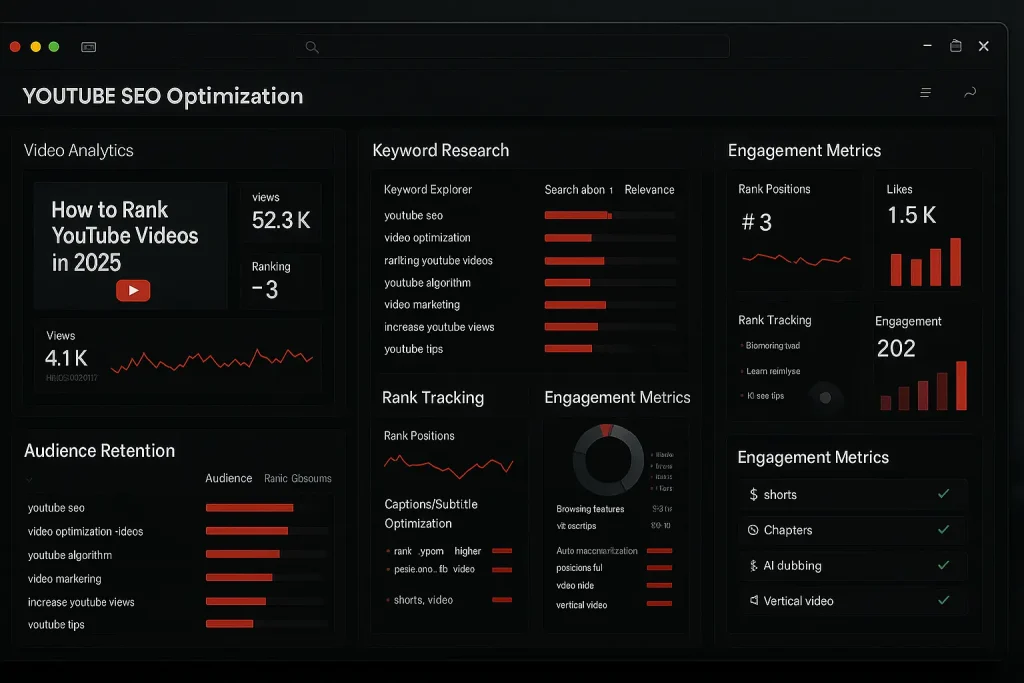You do not “set and forget” search, you maintain it like a living product.
If that sounds obvious, good, because the companies winning organic today treat SEO maintenance as a habit, not a scramble. They keep a short, tight loop between what people search for, what Google rewards, and what their site delivers. That loop is your moat.
What “SEO maintenance” really means
It is the ongoing work that sustains and improves rankings, not a quarterly rescue mission. In practice, SEO maintenance is a system of small, boring, high‑leverage moves that keep your site healthy, fast, crawlable, and aligned with real search intent. Think of it like brushing teeth, not root canal.
Memorable line, because it is true, maintenance beats miracles.
What goes in the bucket:
- Checking performance and fixing what slipped, before it snowballs.
- Refreshing content so it fits how people search today, not last year.
- Tightening technical basics, links, speed, and structured data.
- Safeguarding authority, backlinks, and brand reputation across the web.
Rankings are rented, usefulness is owned
Algorithms evolve weekly, user behavior shifts with new interfaces, and AI summaries reshape how clicks flow. The winners adapt faster because their maintenance loop is already running. Your ranking is not a trophy, it is a lease.
Quick truths that shape today’s playbook:
- Core Web Vitals matter for experience and visibility. INP replaced FID in 2024, so responsiveness is now about real interactions.
- Mobile first is not a trend, it is the baseline. Google indexes using the mobile version, so desktop‑only fixes will not save you.
- Low‑quality content burns trust. Since 2024, helpfulness and site‑level quality signals weigh heavier, so content farms fade while useful pages climb.
- Zero‑click and new result types exist, so your snippets must earn interest, not just rank.
Consistency beats heroics
Systm beats intensity. Use this always‑on rhythm to make SEO maintenance stick without hijacking your week.
Weekly, 30 to 45 minutes
- Scan performance: Open Search Console, filter last 7 to 28 days, spot pages with falling clicks or CTR. Flag outliers, do not debate them.
- Triage issues: Check Indexing report, Page Experience, enhancements. Fix anything red or spiking.
- SERP spot‑check: For your top 10 URLs, eyeball the current results. Has intent shifted to video, tools, or forums, adjust titles and hooks accordingly.
These tiny, unglamorous checks are your compounding advantage.
Monthly, 2 to 4 hours
- Content refresh cycle: Pick 4 to 8 URLs with decaying impressions and refresh them. Update stats, sharpen angles, expand sections that fail to match search intent.
- Link hygiene: Crawl the site, close 404s, fix redirect chains, update internal links to point to the canonical destination.
- Local presence: Verify NAP consistency, respond to new reviews, add fresh photos and FAQs, keep holiday hours accurate.
- Backlink audit light: Reclaim lost links, disavow only if truly toxic, prioritize outreach to repair broken high‑value references.
Quarterly, 1 dedicated day
- Technical deep dive: Crawl at scale, validate sitemaps, clean orphaned pages, review canonicals, test CWV on key templates, audit structured data coverage.
- Intent re‑mapping: Reevaluate your top money terms. If the SERP favors comparisons or guides now, reshape your pages to match.
- Content gap sweep: Ship at least one new, legitimately helpful asset that others will cite, a calculator, dataset, teardown, or original study.
- Governance check: Refresh your playbook, naming conventions, internal link standards, and publishing workflow so good habits stay easy.
Fewer dashboards, more decisions.
Tools do not do the work for you, they make the work obvious. Set up a focused view so SEO maintenance becomes second nature.
- Search Console: Queries, pages, CTR, indexing, schema errors. Create saved filters for your money pages.
- Analytics: Pageviews, engaged sessions, conversion events tied to content. Tie every primary page to a measurable goal.
- Crawling: Use Screaming Frog or your crawler of choice for 404s, 301 chains, missing canonicals, wrong hreflang.
- Page speed: Field data over lab data. Track INP, LCP, CLS on the templates that drive revenue.
- Rank tracking, lightly: Watch a focused set of keywords per intent cluster, not a vanity basket.
Clean links make authority flow like a river, not a maze
A dead link is a bad handshake. Users bounce, crawlers waste budget, authority leaks. Your SEO maintenance list must include monthly link hygiene.
Do this, in order:
- Crawl for 404s and 5xx. Fix the source link when you can, do not patch everything with a redirect.
- Collapse redirect chains. Point internal links directly to the final URL.
- Validate canonicals and sitemaps so the right URLs earn signals.
- Add smart internal links to your highest converting pages, especially from fresh content that gets crawled often.
Local trust is a series of small confirmations
If you operate in a city, your map pack is your storefront. Monthly SEO maintenance for local prevents painful surprises.
- NAP consistency: Your name, address, phone must match everywhere.
- Hours and attributes: Update for seasons and holidays. Add services and accessibility details.
- Reviews: Respond to all, highlight specifics, and move repeats to an FAQ.
- Photos and posts: Fresh visuals increase calls and map taps.
- Citations: Maintain key directories where your buyers actually look, industry first, generic second.
A refresh is not a rewrite, it is an upgrade with intent
Good pages rot when the world changes. The antidote is scheduled refreshes that respect intent, not just keywords. This is where SEO maintenance pays in both rankings and revenue.
Your refresh checklist:
- Re‑qualify the intent: Search your primary query, note the top formats, comparisons, checklists, or tools. If the SERP rewards a calculator, add one.
- Update facts: Replace years, product names, and screenshots. Outdated details break trust fast.
- Tighten the hook: Improve your title, H1, and first 100 words so a human wants to click and keep reading.
- Expand useful depth: Add examples, steps, and decision criteria. Aim for genuine problem solving, not word count.
- Refresh internal links: Point to newer, stronger assets. Retire dead ends.
Earn links by being useful, keep links by being dependable
You cannot force people to link, you can control what is link worthy and how you maintain it. As part of SEO maintenance, run these simple motions every month.
- Reclaim: Find broken links to your domain, recreate or redirect the target, ask for updates politely.
- Close the loop: When a partner mentions you without a link, ask for the citation.
- Publish cite‑able assets: Benchmarks, datasets, templates, and teardown posts become natural link magnets.
- Monitor health: If a toxic domain blasts you, evaluate first, disavow only when truly necessary.
Automate reminders, not responsibility
Automation catches small slips fast. Autopilot causes big ones. Use lightweight systems so SEO maintenance is faster, not lazier.
- Alerts: Weekly Search Console performance deltas, Core Web Vitals drops on key templates, 404 spikes.
- Content calendar with SLA: Every money page has a refresh date and an owner.
- Change log: Track edits, redirects, title changes, schema additions, and attach them to outcomes.
- QA checklists: Before publish and after refresh. Titles, H1 alignment, links, images with alt, schema valid.
Technical foundations you should not ignore
Technical excellence does not win on its own, poor technicals can lose on their own. Fold these into your quarterly SEO maintenance day.
- Crawl budget sanity: Noindex thin or private pages, consolidate near duplicates, fix infinite facets.
- Rendering checks: What does the mobile crawler actually see. Verify content, links, and schema in rendered HTML.
- Structured data coverage: Articles, products, FAQs, and breadcrumbs. Validate, then sample real pages.
- Core Web Vitals focus: Measure field data for LCP, CLS, INP on the top traffic templates. Prioritize fixes that move many pages at once.
- International and multilingual: If relevant, validate hreflang pairs and watch for language mix ups.
Culture beats checklists, but checklists help culture
Great systems survive turnover and launches. Document the way you work so SEO maintenance keeps its rhythm when campaigns heat up.
- Roles: Who owns monitoring, who owns refreshes, who merges fixes.
- Standards: Title length ranges, H1 patterns, internal link rules, media naming.
- Publishing workflow: Draft, review, fact check, QA, publish, measure, refresh.
- Scorecards: A simple view of health across content, technicals, and authority, green stays green, red gets an owner.
A simple, real example of the loop
Let us make it concrete. Imagine your guide to “CRM onboarding” slides from position 6 to 11 over two months.
- Week 1: Search Console shows clicks down 22 percent, CTR flat. You spot two forum threads now ranking top 5 with troubleshooting steps your guide lacks.
- Week 2: You add a concise troubleshooting section with real screenshots and a mini‑FAQ, then link it from your product page.
- Week 3: A customer success manager records a 4‑minute walkthrough video. You embed it, compress it, add transcript, and mark up FAQ.
- Week 4: You request two partner success stories to add proof. You also fix three internal links that still point to an old onboarding URL.
- Week 6: You climb back to 6, CTR rises because the title now promises “setup plus troubleshooting”. Leads recover.
What happened, the loop stayed short, the refresh matched intent, and the site got easier to love.
Fix the habits, not just the pages
- Vanity tracking: Watching 500 keywords instead of the 50 that pay the bills.
- Stale snippets: Titles that promise nothing, descriptions that repeat the H1 verbatim.
- Redirect sprawl: Shipping content without cleaning old URLs.
- Thin updates: Changing the year in the title and calling it a refresh.
- One‑off audits: A beautiful PDF, then silence for six months.
Your compact SEO maintenance checklist
Copy it, pin it, live by it.
Weekly
- Scan Search Console, flag drops
- Triage indexing and enhancement issues
- Spot‑check top SERPs for intent shifts
Monthly
- Refresh 4 to 8 URLs, facts, depth, intent
- Crawl, close 404s, collapse 301 chains
- Update local listings, respond to reviews
- Reclaim or repair valuable links
Quarterly
- Deep technical audit, templates first
- Intent re‑mapping for money terms
- Publish one cite‑able asset
- Governance review and scorecard update
FAQ
It is the routine, ongoing process of keeping your site aligned with how search works, from content and technicals to authority and local presence.
Because search evolves and competitors move. Without updates, pages decay, links break, and intent drifts. The fix is not drama, it is rhythm.
Weekly for anomalies, monthly for refresh work, quarterly for deep audits. Tie pages to goals so you know which fixes paid off.
No. Search Console, Analytics, a solid crawler, and page speed telemetry cover most needs. Use more only when they shorten the loop between insight and action.
Use AI to draft or analyze, then raise the bar with expertise, data, and lived examples. Publish pages people save, not pages machines forget.
Rarely. Focus on reclaiming good links and earning new ones. Only disavow when you are confident the links are manipulative and harmful.
Falling impressions or clicks, lower dwell, comments or tickets that reveal missing steps, and SERPs filled with formats you do not cover. Any of those are a yes.
Wrap up
The best teams treat SEO maintenance like athlete training, simple drills, done often, that win on game day. You are not chasing hacks, you are compounding small advantages, page by page.
Start the loop. Keep it short. Measure what matters. Your search pipeline will thank you, and your content will keep earning attention long after the campaigns fade.
Treat SEO maintenance like athlete training, simple drills, done often, that win on game day. Small fixes compound. Useful pages keep earning. Rankings follow.
Why The Hyper Fuel
- Operator mindset: We audit, fix, and ship. Short loops, tight feedback, real owners.
- Refresh engine: Monthly content upgrades tied to intent, with change logs and before‑after metrics.
- Link hygiene: Clean 404s and chains, strengthen internal links, reclaim high‑value mentions.
- Speed and UX: Field‑data Core Web Vitals improvements on the templates that move revenue.
- Local presence: Consistent listings, fast review replies, fresh photos and FAQs where it matters.
- Simple dashboards: Search Console, Analytics, and a plain scorecard. Fewer graphs, more decisions.
- Governance that sticks: Standards, SLAs, and a refresh calendar so good habits survive busy seasons.
Want the rhythm without the heavy lift? Partner with The Hyper Fuel. We set up the cadence, run the weekly checks, ship the monthly refreshes, and report in business terms. Your team keeps building, your search keeps compounding.
Ready to see this working on your site? Start a quick strategy call with The Hyper Fuel. We will tailor the SEO maintenance loop to your stack and show clear progress in the first month, faster pages, cleaner links, and sharper content.




